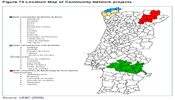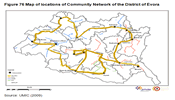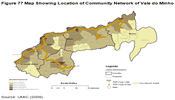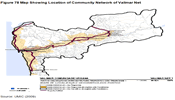Community networks (supported by public funds) are open, public broadband networks, developed in disadvantaged areas or where there are market failures in the provision of electronic communications services.
In general, they link the headquarters of the councils covered, public buildings and buildings of public interest, higher education institutions, technology centres, industrial parks and zones, seeking to drive economic and social development in the community. In fact, the main objectives of this type of project for a given region are to combat info-exclusion, to promote equality of opportunity and public access to broadband, to correct imbalances in communications accessibility and develop technology-based and scientific entrepreneurship.
Such networks can facilitate the return on existing infrastructure of municipal companies (e.g. in the area of water) and complement communications infrastructure constituted in connection with Digital Cities and Regions projects. 1
Community networks commonly have the following characteristics:
a) They are networks of public interest;
b) The serve a local community;
c) All traffic that begins and ends within the network should tend towards no charge;
d) They have technological neutrality and independence;
e) Are open to access and use by any operator or provider of electronic communications services wishing to serve the community;
f) They are not owned by an operator or provider of electronic communications services in the traditional sense;
g) They are controlled independently of any supported service or content.
The network designs have to be neutral in relation to competing technological solutions, and demonstrate economic sustainability and provide equal access to all operators interested in their use. 2
Between February and April 2006, the POSC - Programa Operacional da Sociedade do Conhecimento (Knowledge Society Operational Programme) opened a public tender for community network projects, whose promoters had to be public entities, which should provide for 55% of total costs 3. In April 2007, four Community Networks projects were approved 4 , at a total of 34 million euros (see Figure 75) comprising the regions of Evora, Tras-os-Montes and Minho.
Figure 75 - Location Map of Community Network projects
In conjunction, these projects result in networks which are comprised of more than one thousand kilometres of optical fibre cable, allowing connections and services in very wide broadband supported over optical fibre, in particular between 1 Gbps and 10 Gbps.
These four network projects were almost concluded by the end of 2008, with a length of roughly 1200 kilometres of optical fibre.
Infrastructure tests were conducted on these four networks at the beginning of 2009, followed by the process of bringing fibre first to the network of partners making up each consortium (entities related to local authorities, universities, etc.) and then to businesses and the region’s population. This last phase of operation and development of services is promoted by the municipal associations. These networks will work according to a multi-operator system, selected through the launch of operating tenders 5, in the mode that allows multiple operators to use the infrastructure. The operation phase is expected to begin by the end of 2009
The Valimar Net and Vale do Minho Community Networks, which have the networks interconnected through two rings, have chosen to develop inter-municipal companies through PPP, whose business is the construction, maintenance and operation 6 of optical fibre community networks for sale to operators. In both cases DSTelecom was the main private partner.
In addition to the four projects which are detailed in the following sections, there is also the NetDouro project, which started in 2004, resulting from a partnership between the company AdDP 7 (Águas do Douro e Paiva, SA - extracts and distributes water), and its shareholders and customers, with the mission of creating value in the use of the installed optical fibre network and the aim of exploiting AdDP's own communications infrastructure. In this sense the company NetDouro was founded 8, with this network interconnecting the associated municipalities and allowing the sharing and reduction of electronic communication costs.
This project combines the primary purpose which determined the construction of the AdDP's infrastructure (water supply management system) with the development of projects that can make an important contribution to regional development and, ultimately, improved quality of life of the populations.
It took advantage of the capacity of the communications network installed practically at marginal cost at the time of installation of ducts (coverage of system structures with an optical fibre network had the essential goal of providing the tele-management/telemetry system in AdDP's water distribution), exceeding the needs of AdDP's business, providing a part of this infrastructure, setting up a regional infrastructure, with characteristics of broadband intranet with extremely low access and usage costs, providing a voice, data and image network.
The connection to Vale do Sousa Digital is already functioning and the connection to Maia and Porto Digital made through the respective municipalities. Additionally, connections to further municipalities are envisaged, including Amarante, Resende and Marco de Canavezes. Today NetDouro has an optical fibre network with approximately 400 km of ducts and optical fibre cables, present in eighteen municipalities of Greater Porto and Vale do Sousa, with a population of about 1.7 million inhabitants. 9
"Terra Quente" Broadband of Trás-os-Montes
This project, with a fibre infrastructure of 235 km in length (including 75 km of ducts) is promoted by Associação de Municípios da Terra Quente Transmontana (Association of Municipalities of the "Terra Quente" area in Trás-os-Montes) and involves six municipalities (Alfândega da Fé, Bragança, Carrazeda de Ansiães, Macedo de Cavaleiros, Mirandela, Vila Flor).
The project envisages coordination with inter-municipal planning projects for culture, leisure and telemedicine, as well as the IT integration of various Santas Casas da Misericórdia (Holy House of Mercy), the telemanagement of various public urban and forest CCTV networks, articulation with the "Fun Zone Village Douro" project 10 and facilitation of connectivity with the RCTS 11 which serves the higher education and research institutions in the area covered. The promoter is responsible for developing and laying the entire project, with technical aid provided by Instituto Politécnico de Bragança.
The "Terra Quente" Broadband Network of Trás-os-Montes will have an investment of 7.7 million euros, with 3.5 million euros reimbursed by EU funds. The remaining 4.2 million are distributed among the five municipalities of Terra Quente. It is expected that 90 thousand people will be able to access this NGN.
The "Terra Quente" Community Network of Trás-os-Montes was authorized by the government in March 2009 to borrow 1.8 million for the project's development.
District of Évora
The Community Network project of the District of Évora (see Figure 76) was promoted by AMDE - Associação de Municípios do Distrito de Évora (Association of Municipalities of the District of Évora), involving fourteen municipalities (Alandroal, Arraiolos, Borba, Estremoz, Évora, Montemor-o-Novo, Mora, Mourão, Portel, Redondo, Reguengos de Monsaraz, Vendas Novas, Viana do Alentejo, Vila Viçosa), launched with the signing of the respective construction contracts, occurring on 08.05.2008.
This project should coordinate with inter-municipal planning projects for culture, leisure and the knowledge triangle (education, research and innovation), extending industrial estates and areas, agricultural, agro-industrial and tourism projects for the Évora distinct with the Évora Digital District project and the BDIG - Base de Dados de Informação Geográfica (Geographic Information Database) project and it envisages connectivity with the RCTS network, which serves the higher education and research institutions of the area covered.
Figure 76 - Map of locations of Community Network of the District of Évora
The project envisages a main optical fibre ring of 452 km, with aerial routing and with a 26 km connection to the University of Evora in underground routing, totalling about 480 km. The associated investment totals around seven million euros.
The process of choosing a managing entity for the network took place simultaneously with the tender which chose the partner entity to pass the fibre through the ducts.
The tender launched for the "Design and Construction of the Community Broadband Network of the District of Évora" was awarded to the consortium led by PT PRIME, NEXTIRAONE and ENSULMECI. 12
Vale do Minho
This project (see Figure 77) was promoted by the Comunidade Intermunicipal do Vale do Minho (Vale do Minho Intermunicipal Community) and covers 5 municipalities (Melgaço, Monção, Paredes de Coura, Valença and Vila Nova de Cerveira). It should link up with the Vale do Minho Digital project and the wind farm network, the Valença Logistic Platform and the Business Parks Network.
The promoter is responsible for the development and deployment of the service, with technical assistance provided by Instituto Politécnico de Viana do Castelo.
The project provides an optical fibre infrastructure extending over 135 km and the total project cost is estimated at 9 million euros. To implement a network with an investment of this size, an inter-municipal company was set up called MinhoCom 13.
Figure 77 - Map Showing Location of Community Network of Vale do Minho
Valimar Net
This project, budgeted at about ten million euros, is promoted by VALIMAR ComUrb - Vale-e-Mar Comunidade Urbana (Vale-e-Mar Urban Community) and involves six municipalities (Arcos de Valdevez, Caminha, Esposende, Ponte da Barca, Ponte de Lima and Viana do Castelo). Coordination is envisaged with the Infrastructure Development and Expansion Plan (Optical Fibre Ring of Viana do Castelo), Parquemp - Network of Business Parks, with the Valimar Digital project, Padre Himalaia Knowledge Park, Renewable Energy Projects (biomass and wind), Virtual Campus of the Polytechnic Institute of Viana do Castelo. The promoter is responsible for the development and deployment of the service, with technical assistance provided by Instituto Politécnico de Viana do Castelo.
The project (see Figure 78) envisages an infrastructure of optical fibre extending 240 km and, in line with the Community Network of Vale do Minho, it was decided to create an inter-municipal company, Valicom. 14
Figure 78 - Map Showing Location of Community Network of Valimar Net
1 Another important network, formed several years ago, is the RCTS - Rede de Ciência e Educação (Science and Education Network); this is a computer network linking scientific research and education institutions, also providing a link to the international research and education network, and is operated by FCCN - Fundação para a Computação Científica Nacional (Foundation for National Scientific Computing), a non-profit association whose activities are mainly financed by UMIC-Agência para a Sociedade do Conhecimento, IP (Knowledge Society Agency) and that are associated with FCT - Fundação para a Ciência e a Tecnologia, IP (Foundation for Science and Technology), UMIC - Agência para a Sociedade do Conhecimento, IP (Knowledge Society Agency), CRUP - Conselho de Reitores das Universidades Portuguesas (Council of Portuguese University Recotrs) and LNEC - Laboratório Nacional de Engenharia Civil, IP (National Laboratory for Civil Engineering). See Rede de Ciência e Educaçãohttp://www.umic.pt/index.php?option=com_content&task=view&id=29&Itemid=187.
2 The licensed operators of electronic communications are the only entities which can provide services to private end-customers.
3 UMIC constituted and operated the Technical Support Commission provided for in the regulation of the corresponding measure of POSC to support tenderers in the development of the application process and to monitor deployment of approved projects.
4 Rede Comunitária do Distrito de Évorahttp://www.umic.pt/index.php?option=com_content&task=view&id=28&Itemid=187#evora. Rede de Ciência e Educaçãohttp://www.umic.pt/index.php?option=com_content&task=view&id=29&Itemid=187.
5 See Vector21 - Concursos Públicoshttp://www.vector21.com/cp/?id_categoria=19&id_item=40766.
6 The Valimar Net and Vale do Minho Community Networks are based on a procedure that enables, in the same tender, a private partner to be found to form a joint venture, which partner is not only responsible for building the infrastructure, in future will also be responsible for its management and operation, whereby construction, management and operation falls to the same entity.
7 Águas do Douro e Paiva, S.A. - company of private law and public capital owned 51% by Águas de Portugal and 49% by a group of 18 municipalities (Arouca, Castelo de Paiva, Cinfães, Espinho, Felgueiras, Gondomar, Lousada, Maia, Matosinhos, Oliveira de Azeméis, Ovar, Paços de Ferreira, Paredes, Porto, Santa Maria da Feira, São João da Madeira, Valongo, Vila Nova de Gaia). Águas do Douro e Paiva is concessionaire of the multi-municipal system surrounding the city of Porto until 2026.
8 NetDouro - Gestão de Infra-estruturas de Telecomunicações, SA, was founded in May 2004 and endowed with a capital of one million euros, as a subsidiary of AdDP.
9 Técnicos da AdDP Intervêm no Encontro Nacional de Entidades Gestoras de Água Saneamento and DSTELECOM S.A.http://www.addp.pt/pt/noticia.php?ref=522.
10 Fun Zone Village Douro was presented publicly in May 2006, with its location planned for Alfândega da Fé. This is an "innovative" tourism project to be deployed in an area of one hundred hectares, creating eight hundred beds. The initiative involved an investment of 250 million euros, which would have a large impact on the local and regional economy by directly and indirectly generating hundreds of jobs, with additional associated projects, including the transformation of the airfield in Mirandela into a regional airport with capacity to receive international flights, and a container factory, in Macedo de Cavaleiros.
11 Rede Ciência Tecnologia e Sociedade (Technology and Society Network).
12 AADRAL - Rede Comunitária em Banda Larga do Distrito de Évorahttp://www.adral.pt/index.php?option=com_content&task=view&id=285&Itemid=2&lang=pt.
13 The Vale do Minho Intermunicipal Community (predecessor of Vale do Minho-AM) in partnership with DSTelecom and CellCraft, International Ltd., formed an inter-municipal company called MinhoCom - Gestão de Infraestruturas de telecomunicações, E.I.M. This company's main activity is the construction and operation of the Community Network of Vale do Minho, in a regime of public service. The Association of Municipalities of Vale do Minho holds 51% of the company's social capital with the remaining 49% subscribed by the project's private partners. See MINHOCOMhttp://www.valedominho.pt/portal/page/valedominho/ValedoMinho/Parcerias/MINHOCOM.
14 This is a municipal company brings together the six municipalities of Valimar, with the goal of building and managing this network. The company's share capital is 50 thousand euros, 51% held by Valimar ComUrb, 48.5% by DSTelecom and 0.5% by CellCraft International. See http://www.radiogeice.com/site_radio/index.php?option=com_content&task=view&id=4963&Itemid=1 and http://www.computerworld.com.pt/content/view/6508/52/.








